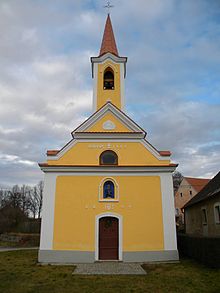Malíkov nad Nežárkou
| Malíkov nad Nežárkou | ||||
|---|---|---|---|---|
|
||||
| Basic data | ||||
| State : |
|
|||
| Region : | Jihočeský kraj | |||
| District : | Jindřichův Hradec | |||
| Municipality : | Horní Pěna | |||
| Area : | 589 ha | |||
| Geographic location : | 49 ° 6 ' N , 15 ° 1' E | |||
| Height: | 500 m nm | |||
| Residents : | 71 (March 1, 2001) | |||
| Postal code : | 378 31 | |||
| License plate : | C. | |||
| traffic | ||||
| Street: | Horní Pěna - Dolní Žďár | |||
Malíkov nad Nežárkou , until 1947 Německý Malíkov ( German German Moliken ) is a district of the municipality Horní Pěna ( Oberbaumgarten ) in the Czech Republic . It is located three kilometers south of Jindřichův Hradec and belongs to the Okres Jindřichův Hradec . The place was laid out as a Rundangerdorf .
geography
In the north lies Dolní Pěna ( Niederbaumgarten ), in the west Dolní Žďár ( Niedermühl ), in the south Nová Ves ( Schönborn ) and in the east Horní Pěna ( Oberbaumgarten ).
history
The place was first mentioned in 1256. The registers of the place have been kept in Oberbaumgarten since 1610. The Czech name form “Niemeczky Malikow” appears in the land register from 1654 of the Neuhaus rule, although the local documents of the same time only mention “Teutsch-Molliken”. In the years 1770 to 1771 the place lost up to two thirds of the inhabitants due to hunger and plague. A major fire in 1892 also destroyed 53 houses. In the 19th century the village of Schönborn was founded, which until 1923 was part of the “Deutsch-Moliken” community. In 1895 a two-class elementary school was built in the village. At the turn of the century, excavations to the south of Deutsch Moliken discovered finds from the Bronze Age.
After the First World War and the Peace Treaty of Saint Germain in 1919, the place, whose residents in 1910 belonged exclusively to the German language group, became part of the new Czechoslovak Republic . In the interwar period, there was an increase in the influx of people with Czech identity due to the appointment of new officials and new settlers. The place was electrified in 1929. After the Munich Agreement in 1938, the place came to the German Reich and became part of the Reichsgau Niederdonau .
After the end of the Second World War , which claimed 18 victims among the inhabitants of Deutsch Moliken, the community came back to Czechoslovakia. The end of May 1945, the residents of German Moliken across the border to Austria sold . According to the Beneš Decree 108, the entire property of the German residents as well as the public and church German property were confiscated and placed under state administration. The place was repopulated. On June 16, 1964 Malíkov nad Nežárkou was incorporated into the neighboring village of Horní Pěna.
Coat of arms and seal
All legal matters were dealt with in the neighboring community of Oberbaumgarten and became legally binding with its seal. In the 19th century, German Moliken is said to have had its own municipal seal with a picture of a plow, but no imprint of it has been found to this day.
Population development
| census | Total population | Ethnicity of the inhabitants | ||
|---|---|---|---|---|
| year | German | Czechs | Other | |
| 1880 | 464 | 459 | 5 | 0 |
| 1890 | 456 | 455 | 0 | 1 |
| 1900 | 391 | 391 | 0 | 0 |
| 1910 | 375 | 375 | 0 | 0 |
| 1921 | 357 | 330 | 14th | 3 |
| 1930 | 311 | 295 | 14th | 2 |
| 1991 | 84 | |||
| 2001 | 71 | |||
Attractions
- Chapel of the Holy Virgin Mary (1849), with bell from 1892, Renaissance altar by the sculptor Neubauer and with the statue of St. Maria von Loretto von Stufleser
- War memorial (1935)
literature
- Felix Bornemann: Arts and Crafts in South Moravia. South Moravian Landscape Council, Geislingen / Steige 1990, ISBN 3-927498-13-0 , p. 4.
- Bruno Kaukal: The coats of arms and seals of the South Moravian communities. In the home districts of Neubistritz, Zlabings, Nikolsburg and Znaim. South Moravian Landscape Council, Geislingen / Steige 1992, ISBN 3-927498-16-5 , p. 46.
- Gerald Frodl, Walfried Blaschka: The district of Neubistritz (South Bohemia) and the Zlabingser Ländchen from A to Z. South Moravian Landscape Council, Geislingen / Steige 2008, p. 47 f.
Web links
Individual evidence
- ↑ http://www.uir.cz/katastralni-uzemi/643670/Malikov-nad-Nezarkou
- ↑ Bruno Kaukal: The coats of arms and seals of the South Moravian communities. In the home districts of Neubistritz, Zlabings, Nikolsburg and Znaim. 1992, p. 46.
- ↑ Heinrich Richly: there are new findings that confirm the acceptance of prehistoric connections between southern Bohemia and the Danube. In: Meeting reports of the Anthropological Society in Vienna. 1902, ZDB -ID 206024-3 , pp. 38-40, here p. 38 .
- ^ Josef Bartoš, Jindřich Schulz, Miloš Trapl: Historický místopis Moravy a Slezska v letech 1848–1960. Volume 9: Okresy Znojmo, Moravský Krumlov, Hustopeče, Mikulov. Profil, Ostrava 1984.


